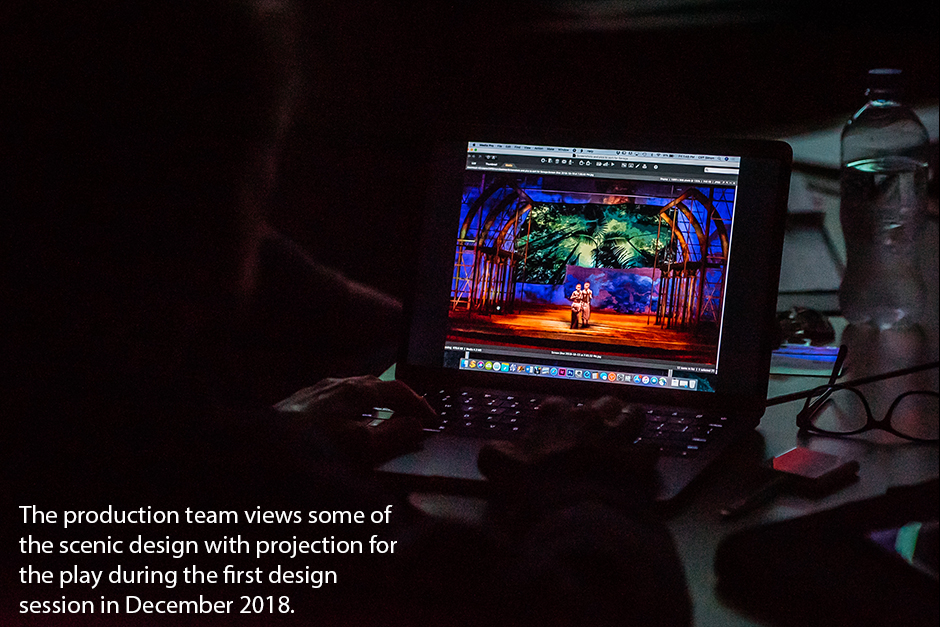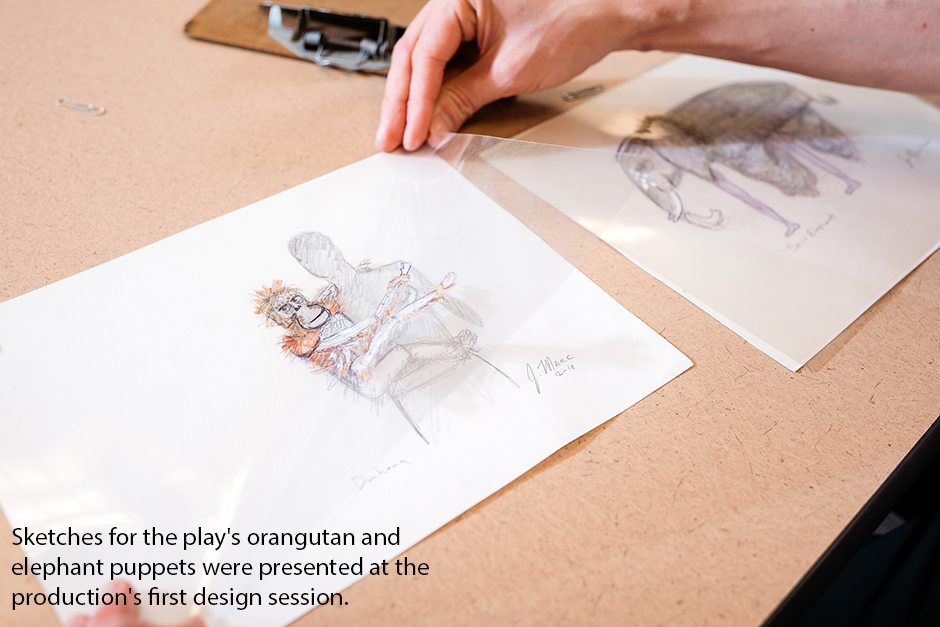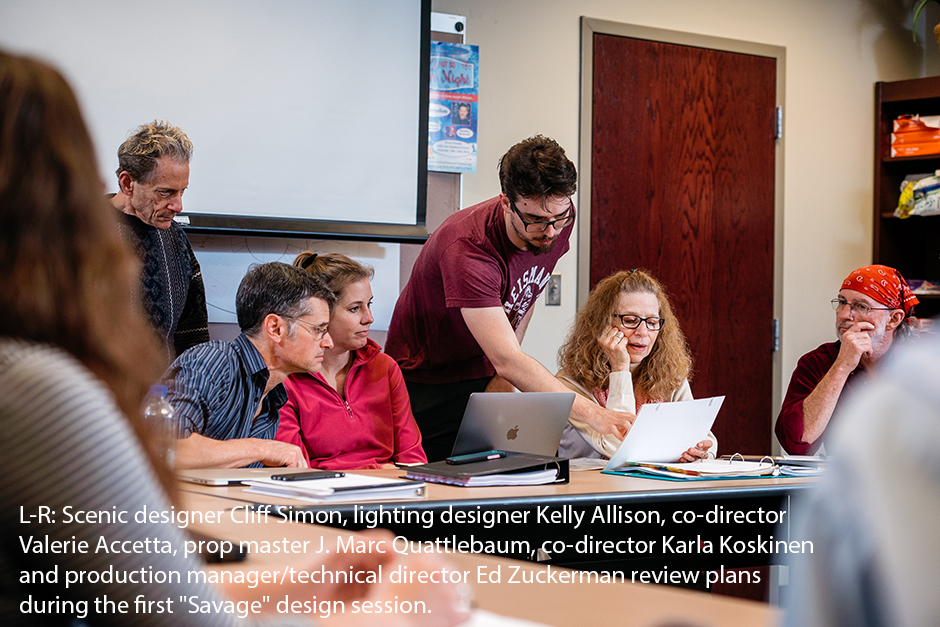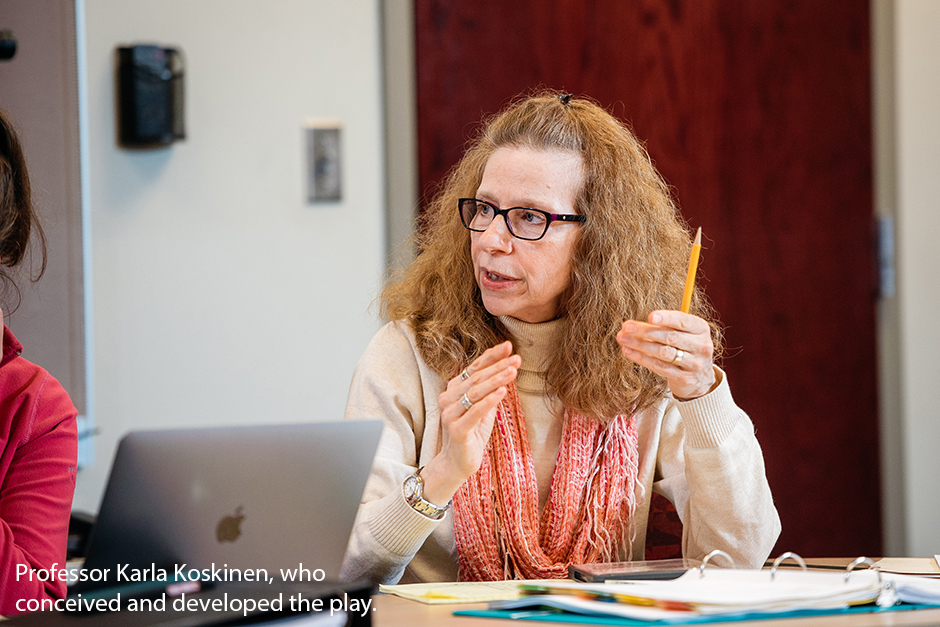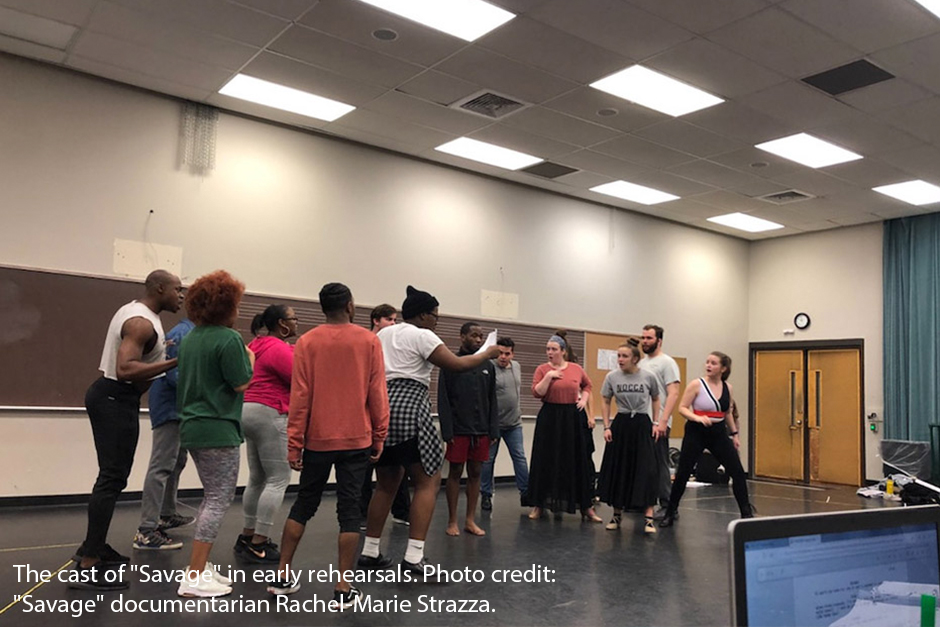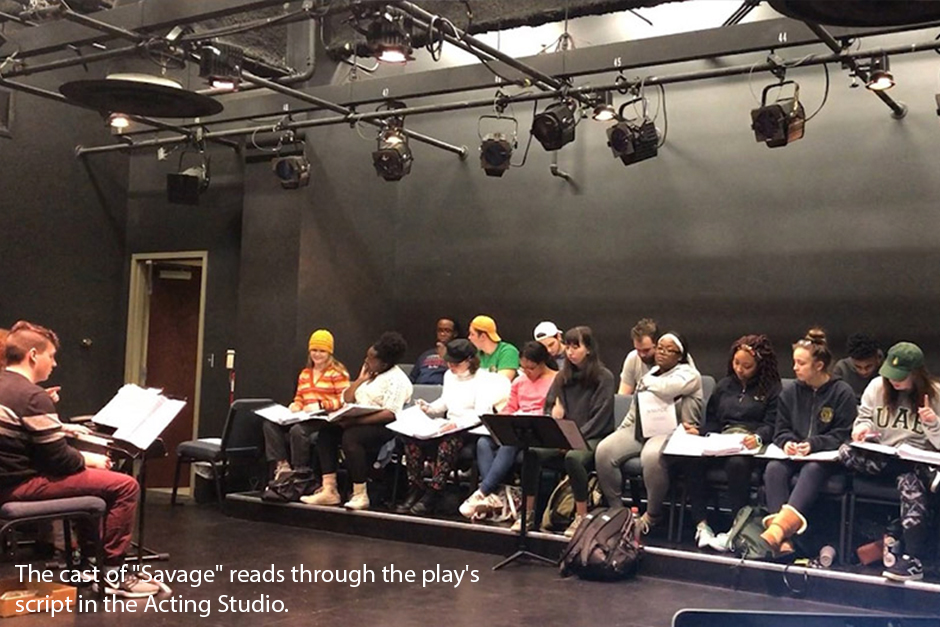An epic story of one man’s tragic life being created by Theatre UAB will have its world premiere April 10-14, at the University of Alabama at Birmingham.
| “I’ve come to tell you a story, to ask you a question, to take inventory, to breathe life into a name that was almost erased, to face a truth we haven’t yet faced.” – The Storyteller, “Savage.” |
The original musical, “Savage,” was conceived and developed by UAB Professor of Theatre Karla Koskinen, who has researched and worked on the play for more than three years. She has worked with composers Tommy Newman and Jaime Lozano to create the show’s music, and Newman wrote the book and lyrics. Students and faculty in the College of Arts and Sciences’ Department of Theatre have played a pivotal part in every step along the way, from critiquing the developing script to bringing it to life on stage.
The play spans history and continents to recount the startling, true tale of a Mbuti man, Ota Benga, taken in the early 1900s from Africa by missionary and anthropologist Samuel Verner for exhibition at the St. Louis World’s Fair and, later, The Bronx Zoo. Displaced and cruelly exploited for his physical characteristics, including his skin color, short stature and ritually filed teeth, Benga is left to marginally exist in a world he does not understand, never able to return to his homeland. The musical blends fiction and history with dance, traditional African Congo music and ragtime with contemporary melodic and rap styles.
Senior Royzell Walker of Cincinnati, Ohio, a musical theater major graduating in April, will originate the part of Ota Benga, a challenging, emotional journey for him.
“This story is a lot bigger than me, bigger than this cast,” Walker said. “I am not only speaking for Ota Benga, but for other African-Americans around the world, because we have to deal with these things every day of our lives. ‘Savage’ is a very disturbing story. But it happened, and it is a part of our history that cannot be erased. You think you could imagine how he felt in these horrible situations, but you can’t. You simply can’t. No one could imagine the pain that he must have felt. Every rehearsal, I have to become Ota Benga, so I get a glimpse of that.”
In the play, “we talk about putting a man in a cage, and how many of our black men are still put in cages,” Koskinen said. “This contemporary practice parallels the historical story of Ota Benga. In both instances, the stories are often buried, and we wanted to examine how the past and present intersect. This compelling exploration resonated with all of us. This will add one more voice to the conversation, and it is critically important that we keep having the conversation.”
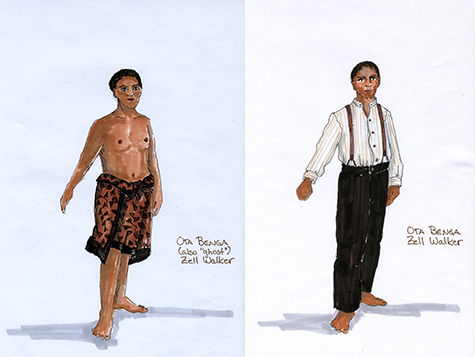 Costume sketches by "Savage" Costume Designer Kimberly Schnormeier.The challenge of the title
Costume sketches by "Savage" Costume Designer Kimberly Schnormeier.The challenge of the title
In creating the work, the biggest challenge has been the title, Koskinen says. Throughout the play Benga is called “the littlest savage.” The acts of savagery are, in fact, committed against him.
“I think the audience may be uncomfortable at various points during the play, in the same way when we go to the civil rights museum and see those shocking pictures, we are incredibly uncomfortable,” Koskinen said. “But we understand that owning our history is the only way to move forward.”
Benga was born in the early 1880s in the Congo Free State. He was a member of the eastern Bambuti, or “Forest People,” of Central Africa, a group of hunter-gatherer tribal ethnicities distinguished by their short stature and known as “Pygmies,” now considered a derogatory term for people from Africa.
Sold by African slave traders to Verner, he was sent to the United States and put on display with other native peoples in the St. Louis World Fair in June 1904. He returned to Africa, but sadly ended up back in the United States, where he was housed in the American Museum of Natural History in New York City. Benga then moved to the Bronx Zoo in 1906 and was put on display alongside monkeys and apes.
Black religious leaders there secured his release. Despite the fact that Benga was a grown man, he was sent to live in a church orphanage in Lynchburg, Virginia, where he went to school and was tutored by poet Anne Spencer. His sharp teeth were capped and he was attired in clothing. When World War I started, and passage back to Africa became impossible, he grew despondent. In 1916, and still in Virginia, Benga went into the woods and built a fire, removed the caps from his teeth and his Western clothes, and shot himself.
Theatre UAB has a long history of finding and commissioning new works and choosing plays for its season to provide the finest performance opportunities for the students in the department, says Chair Kelly Allison, MFA. For three decades, Theatre UAB’s Ruby Lloyd Apsey Play Search has sought new and original full-length plays that confront racial or ethnic issues, especially those calling for ethnically diverse and/or multiracial casting.
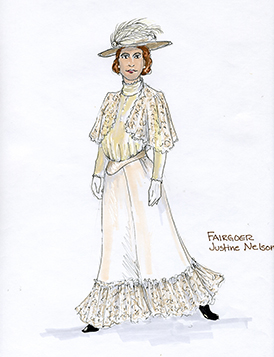 Costume sketches by "Savage" Costume Designer Kimberly Schnormeier.Bringing the play to life
Costume sketches by "Savage" Costume Designer Kimberly Schnormeier.Bringing the play to life
Koskinen recruited a stellar team of artists to bring the project to life. Newman, a theater faculty member at Troy University, wrote the book and lyrics. New York composer Lozano also created the music along with Newman.
Language translations and guidance were provided by Kazadi Wa Mukuna, Ph.D., a native of the Democratic Republic of the Congo and an author, professor of ethnomusicology at Kent State University and director of the African Ensemble at the Hugh A. Glaiser School of Music. They also collaborated with native speakers of Chiluba, the language that Benga spoke, for assistance in teaching chanting to the actors as well as translation.
Theatre UAB’s head of Musical Theater, Valerie Accetta, MFA, is co-directing with Koskinen, with musical direction by Carolyn Violi and choreography by Roy Lightner.
Theatre UAB’s properties master J. Marc Quattlebaum visited the Center for Puppetry Arts in Atlanta to prepare for construction of the show’s giant diaphanous elephant puppet, which plays a central role in Benga’s connection to his tribe, culture and homeland. Sophisticated professional projections will help the scenery transform, from the open sky of the jungles of Africa to the cities and forests of America, including the World’s Fair and the St. Louis skyline.
A cast of 20 actors will each play two or even three roles, except for the actors playing Benga and Verner, who will not play anyone else. Rehearsals for this production started months before most Theatre UAB productions, and actors have worked hard on the vocal skills needed.
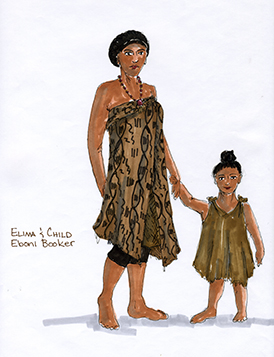 Costume sketches by "Savage" Costume Designer Kimberly Schnormeier.Intricate details shine
Costume sketches by "Savage" Costume Designer Kimberly Schnormeier.Intricate details shine
The Theatre UAB Costume Shop is a whirl of activity. More than 40 hours of work went into simply planning and sketching the costumes.
There are 85 head-to-toe costume looks, says costume designer and Associate Professor Kimberly Schnormeier, MFA, and the shop will build about 50 individual looks for the show. Lots of tricks are employed for super-fast costume changes. There are present day costumes, early 20th century costumes and costumes of the indigenous African peoples represented in the play. Theatre UAB is creating its own painted textiles that will be worn by members of Benga’s tribe. Student designer Claire Stewart has developed the patterns, and the department’s costume crafts class will participate in the stamping and painting of these textiles.
“The Mbuti men would make bark cloth by pounding the bark of trees into a thin layer to create a textile, and the women of the tribe would then decorate the cloth with charcoal and natural pigments,” Schnormeier said. “Originally these designs had traditional symbolic meanings. We are using them primarily as a decorative element to identify the Mbuti people. Ota Benga will be wearing a design inspired by the bark cloth he wore in an existing photo. Our textile designs will be a combination of stamped and hand-painted designs on hand-dyed linen.”
Students are part of the development of the work in many ways. At a formal reading of the script, two students expressed their concerns and suggestions. In that version of the script, Benga was never in Africa, and the audience never got to see him developed as a family man before he is victimized. Koskinen says she and Newman went back to the drawing board and changed the show because of these students’ incredible perceptions.
|
Performances are at 7:30 p.m. April 10-13 and at 2 p.m. April 14 in UAB’s Alys Stephens Performing Arts Center, Sirote Theatre. Admission is $15 and $20; student tickets are $6. Tickets for UAB employees and senior citizens are $10. For tickets, call 205-975-2787 or go to www.AlysStephens.org. Visit Theatre UAB online at www.uab.edu/cas/theatre. |
“Their sensitivity to the story we were trying to tell helped shape it,” Koskinen said.
Creating a new play means changes will happen. Already the script has changed so much that the department has used 30,000 sheets of paper making copies for the team, who work on it daily. Production meetings, usually held in a conference room, were moved to a larger classroom and the extensive production team filled it.
The play will have life beyond UAB. The team has applied to participate in the National Alliance of Musical Theatre Festival, which is how musicals can be seen in New York by producers and others who are interested in developing plays further, Koskinen says. There is already interest in the project, and if the production is not invited to the festival, Theatre UAB plans to take the play to New York and do their own reading.
